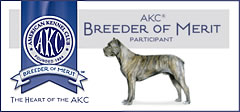IMPORTANT: If you have a serious concern that your dog or puppy has distemper, it is vitally important that you contact your vet immediately! The sooner you get your puppy on fluids and support, the better your chances of saving its life from this often deadly disease.
Canine Distemper:
Canine distemper, often referred to as 'distemper', is among the most common and deadly virus infections for dogs. This preventable disease is a highly contagious, incurable, and often deadly virus that is easily contacted and is particularly fatal for young puppies and non-immunized senior dogs. Distemper is spread through the air (by sneezing or coughing), and the virus can be passed on by direct contact with an infected dog (or contact with infected fresh urine, blood or saliva), or indirect contact (i.e. sharing food and water bowls, utensils, bedding etc) with an infected animal. Distemper is a highly contagious and serious viral illness with no known cure, yet is easily avoidable with proper vaccination and care to prevent opportunity for infection in unvaccinated pups. Reported mortality rates for dogs infected with canine distemper virus range between 40-60%, drastically jumping to over 80% fatality for young puppies, with a worldwide mortality rate second only to rabies. Canine distemper infection is a systemic, viral disease that affects a dog’s respiratory, gastrointestinal, respiratory and central nervous systems, as well as the conjunctival membranes of the eye. Symptoms include sneezing, coughing, watery or thick mucus discharge from the eyes and nose, high fever (102 degrees Fahrenheit or 39 degrees Celsius), reddened eyes, lethargy, sudden vomiting, diarrhea, depression, persistent coughing, and/or loss of appetite. In the later stages of the disease, the distemper virus starts attacking the other systems of the dog’s body, particularly the nervous system. The brain and spinal cord are affected and the dog may start having fits, seizures, paralysis, and attacks of hysteria.
Infection:
Distemper is a highly contagious, incurable, and often deadly viral illness. Direct or indirect contact with an infected animal can easily spread the infection to your pup. Distemper virus is spread through the air (by sneezing or coughing), passed on by direct contact with an infected dog (or contact with infected fresh urine, blood or saliva), or indirect contact (i.e. sharing food and water bowls, utensils, bedding etc) with an infected animal. Contamination can be brought home to your pup on shoes, paws, hands and even car tires that have come in contact with an infected dog or fluids.
Incubation Period:
The onset of clinical canine distemper symptoms usually go unnoticed. The incubation period, from exposure and infection to visible onset of clinical symptoms varies between three (3) to six (6) days after infection. It is also important to note that any infected dog or pup will shed contiguous virus particles from the point of exposure and for an additional 60 to 90 days after all symptoms have disappeared.
Symptoms:
Supportive care is the main treatment while the infected dog builds up his immune response, making it of utmost importance that you get your pup to a vet IMMEDIANTLY if you suspect it has contacted distemper. Early clinical canine distemper symptoms usually go unnoticed, but as the disease progresses the symptoms increase in severity. Early symptoms include loss of appetite, fever, mild eye irritation, sneezing and coughing. Respiratory and gastrointestinal symptoms include watery eyes and nose - usually with a thick green mucus discharge, diarrhea, coughing, labored breathing, and vomiting. In the later stages of the disease, the distemper virus starts attacking the other systems of the dog’s body, particularly the nervous system. The brain and spinal cord are affected and the dog may start having fits, seizures, paralysis, and attacks of hysteria.
Initial Symptoms usually begin with:
- High Fever
- Loss of Appetite
- Mild Eye Inflammation
- Sneezing
- Coughing
Secondary Symptoms soon follow, including:
- Depression
- Refusal to Eat
- Respiratory Distress
- Watery / Runny Eyes and Nose
- Thick Green Mucus Discharge from Eyes and Nose
- Gastrointestinal Distress
- Vomiting
- Diarrhea
Later Stages target the nervous system, affecting the brain and spinal cord, symptoms including:
- Shaking
- Trembling
- Twitching
- Spasms
- Fits
- Uncoordination
- Increased Sensitivity to Light, Touch, and Sound
- Seizures
- Paralysis
- Blindness
- Foaming at the Mouth
- Attacks of Hysteria
Occasionally, certain strains of the canine distemper virus cause skin lesions including abnormal enlargement, thickening, or hardening of the foot pads and nose may be seen.
Recovery is possible with supportive care, although dogs who recover from canine distemper may also have lingering seizures or other central nervous system disorders, or they may be left with permanent brain and nerve damage. Many of these symptoms may not show up until months or years later.
Diagnosis:
A suspected distemper infection is diagnosed by physical examination from a veterinarian, signalment (age, vaccination status, breed, etc.), and a distemper test. Additional diagnostics can include biochemical tests and urine analysis, which may also reveal a reduced number of lymphocytes, the white blood cells that function in the immune system in the initial stages of the disease (lymphopenia). A serology test may identify positive antibodies, but this test cannot distinguish between vaccination antibodies and an exposure to a virulent virus. Viral antigens may be detected in urine sediment or vaginal imprints. Haired skin, nasal mucous, and the footpad epithelium may also be tested for antibodies.
Treatment:
"An ounce of prevention is worth a pound of cure." Benjamin Franklin may not have had distemper in mind regarding this quote, but it is certainly applicable.
There is no 'treatment' or 'cure' for distemper. All your vet can do is provide fluids and supportive care while the disease runs its course. Without intense treatment and IV or SubQ fluids will help prevent dehydration, while antibiotics will be given to help ward off secondary infections while the infected dog builds up its immune response. Phenobarbital and potassium bromide may be needed to control convulsions and seizures.
There is no specific treatment therapy to eliminate the virus itself. Most dogs that recover do so with the help of appropriate supportive care focused on the restoration of fluid balance and prevention of secondary infection.
Recovery is possible with supportive care, although even if a pup manages to survive distemper, it may be permanently affected with lingering seizures or other central nervous system disorders, or it may be left with permanent brain and nerve damage. Many of these symptoms may not show up until months or years later.
Disinfection:
The distemper virus is simple to kill with basic disinfectants, and will also deactivate in sunlight, heat and drying conditions. In most areas where the temperature exceeds 68 degrees Fahrenheit (20 degrees Celsius), shed canine distemper virus organisms will be deactivated within a few hours to a few days after being consistently exposed to this temperature or greater. In colder or freezing conditions, shed distemper virus cells can survive for a number of weeks.
Household bleach at a 1:30 dilution (one part bleach to thirty parts water) will kill shed distemper virus cells. The solution must be applied thoroughly to ALL contaminated surfaces and left on for at minimum of 10 minutes to be effective. You can also use commercial disinfectant products. Quaternary ammonium compounds (QUATs), also termed cationic disinfectants or cationic surfactants, are probably the most common disinfectant substances used by most households today. They are readily available and work well in the killing of canine distemper virus shed cells. When bringing home a new puppy, you can wash your puppy pen, floor, your shoes, and any area your unvaccinated pup will come in contact with to kill any lurking distemper cells and prevent the potential for infection. The more you disinfect every area and item (crates, pens, food and water bowls) your pup will be exposed to that could possibly have been contaminated, the more you reduce the risk of your dog picking up a distemper infection.
Prevention:
"An ounce of prevention is worth a pound of cure." -Benjamin Franklin
Distemper is easy to prevent, but difficult (if not impossible) to treat. Puppies are especially prone to distemper due to their young immature immune systems. Vaccination is the key to prevent this disease and protect your dog. Protecting your pup from possible exposure to canine distemper virus during the period before it is fully vaccinated is critical to its health and wellbeing.
If your pup goes home to you before vaccinations are complete, it is vitally important that you take him/her to your vet to receive the remaining boosters. Your puppy *will not* be protected (against parvo, distemper etc.) until it has received the full set of vaccinations and booster shots.
FULLY VACCINATE ~ BEFORE TAKING YOUR PUP OUT: Protecting your pup means you do not EVER put an unvaccinated pup in a situation where it could contact distemper. I can not stress this enough. Until your puppy is COMPLETLY vaccinated, do not take the chance of your new little one being exposed to Parvo/Distemper. This means, until fully vaccinated, your pup stays in your home, in a controlled environment. Trips to the vet are held/crated - not allowed to walk on the floor, sniff noses with other dogs, or be petted by strangers. Don't let your unprotected puppy run on the grass, stroll down the sidewalk, or play with the neighbors dog. Distemper can lurk anywhere. At best, you will rack up a vet bill in the thousands in a matter of days trying to save your puppy ... At worst, your puppy will suffer and die despite anything your vet can do. Your pup's life is not worth taking that chance.
Pups will get their initial start at immunity thru colostrum from their dam. We recommend vaccinations and booster shots for parvo/distemper should be given at 6, 9 and 12 weeks of age.
Some veterinarians also booster at 16 and 20 weeks, depending on the breed and distemper risk in your area. You can speak with your veterinarian about what vaccination protocol is the best for your pet and your lifestyle, however, we encourage you to also educate yourself and do your own research regarding the dangers of over-vacinating, and vaccinosis.
IMPORTANT: If you have a serious concern that your dog or puppy has distemper, it is vitally important that you contact your vet immediately! The sooner you get your puppy on fluids and support, the better your chances of saving its life from this often deadly disease. |



